Food dehydrators are small countertop appliances that may be used for drying fruits, vegetables, seeds, herbs, fish, meat, and more.

If you are an avid gardener, hiker, or backpacker, follow a raw foods diet, or are interested in the prepping lifestyle, then owning your own dehydrator will save you a lot of money versus buying pre-packaged dried or freeze-dried food from the store.
The biggest benefit to drying food over canning or other preservation methods is that the finished product takes up much less space. The process of dehydrating shrinks the total size of a given item by removing the water – which makes up most of the bulk of our food.
This creates shelf-stable snacks and meals that can easily be stored in a cool, dry place for up to a year, or even longer according to some experts.
However, there is a learning curve with drying food. The good news is that we have thoroughly researched the topic so you don’t have to.
In this comprehensive article, we explain exactly what you need to know about how to get started using a dehydrator, as well as offering our review of 7 of the most popular models.
What You’ll Learn
Read on to learn everything you ever wanted to know about drying food after discovering the top dehydrating appliance contenders!
Discover 7 Popular Food Dehydrators
Whether you’re looking for a larger model to dry produce and meat in bulk, a lightweight option that takes up a smaller footprint, or an appliance that can help you to make yogurt or fruit leather at home, there’s something for everyone!
Here are our favorites on the market today, starting with our top pick for most households.
1. Our Top Pick Up Front: Excalibur 3926T
The Excalibur 3926T is a top-of-the-line horizontal shelf tray model that provides fast and efficient drying as the air moves horizontally from back to front across all nine trays. It is our top pick among these appliances for home use.
Each tray can be removed individually for easy handling or to accommodate larger items, and with the back-mounted heater and fan, there’s no chance of liquids dripping onto electrical components and possibly retaining odors.
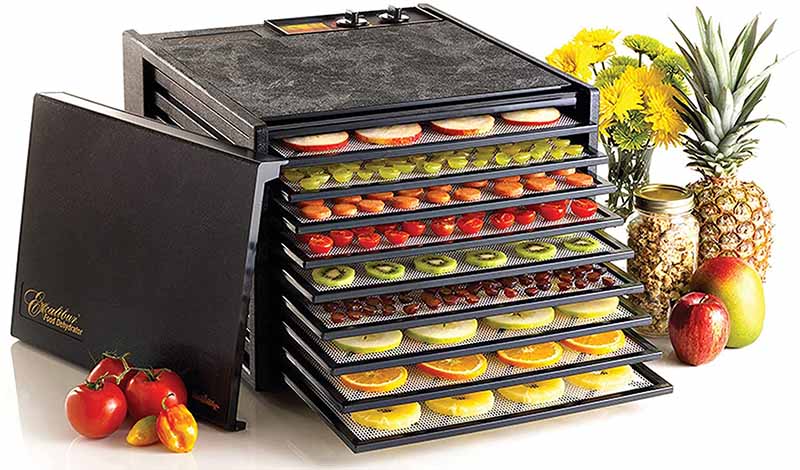
Excalibur 3926T, available on Amazon
With 15 square feet of drying surface, a seven-inch fan, and 600 watts of power, this model meets the needs of large families, those with big gardens, sportsmen, and avid cooks and bakers. In fact, it can be used to proof dough or make yogurt too!
It measures 19 by 17 by 12.5 inches, and weighs 22 pounds.
Made in the USA of durable plastic, the Excalibur offers easy-to-use controls, and a programmable timer for up to 26 hours. The thermostat is adjustable to between 105 and 165°F.
Its superior quality and long 10-year warranty make the 3926T one of the best on the market – and it gets top marks in the Foodal test kitchen.
You can read our full review of the Excalibur 3926T here, or find it now on Amazon.
2. Nesco FD-1040 Gardenmaster
There’s no doubt that the Excalibur 3926T is a top dehydrator. But it’s also a bit large and pricey for some consumers.
If your needs run more to preserving smaller quantities of snacks and jerky, the Nesco FD-1040 Gardenmaster is a great choice.
It offers some nice features that are usually found only in higher priced units, and they score big points with the home-dehydrating hobbyist.
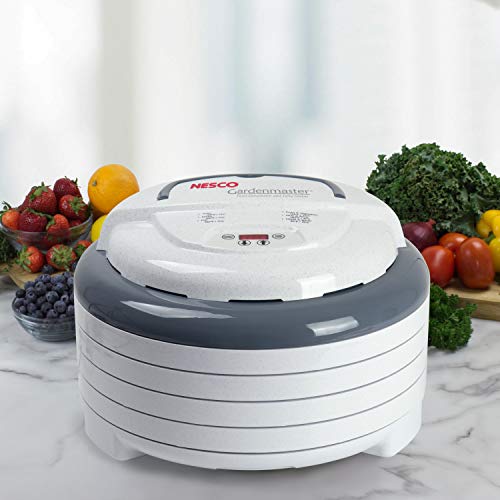
Nesco FD-1040 Gardenmaster, available on Amazon
That includes a 48-hour timer, fruit roll liners for each tray, and mesh liners to keep smaller items from falling through as they shrink. It’s expandable to 20 trays.
With 1,000 watts of power, Nesco’s patented airflow system, and a top-mounted heater and fan, this model dries a variety of foods quickly and consistently. The temperature is adjustable from 90 to 160°F.
This model offers just eight square feet of drying area, so it’s not designed for beginning your own home-based jerky business. But it is ideal for those who want to take advantage of sales, processing a small garden harvest, or making healthy snacks.
It measures 15.5 by 15.5 by 9.5 inches, and weighs 8.95 pounds.
The Gardenmaster is made in the USA with components made in China. It comes with a limited one-year warranty.
There are other Gardenmaster models available, including the larger Pro FD-1018A, but we think this is the best model in that line. Read our full review of the FD-1040 here. Or check current prices and read customer reviews on Amazon now.
3. Presto 6301 Dehydro
Presto is a well-respected name in countertop appliances, so it comes as no surprise that the Dehydro 6301 Electric Dehydrator is such a popular, well-reviewed model.
It’s ideal for those who want to dry smaller-sized batches, for occasional use, or for those who simply don’t want to invest a lot of money in a dehydrator.
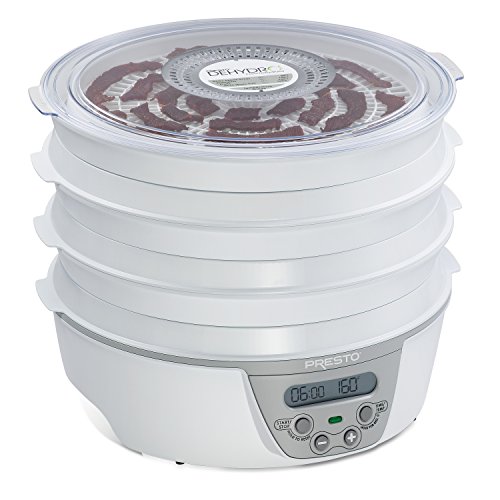
Presto 6301 Dehydro, available on Amazon
This is a six-tray stackable unit with a bottom-mounted heating unit and fan.
Expandable up to 12 trays, the Dehydro also includes a generous array of accessories for making fruit leather, and for drying smaller items such as herbs, nuts, and spices.
The 700-watt heater and fan offer consistent, even heating from 90 to 160°F. The programmable 48-hour timer and adjustable thermostat are nice additions at this price point.
It measures 14.5 by 15 by 7.25 inches, and weighs 8.25 pounds.
Easy to use and clean, the Presto 6301 Dehydro has found a welcome niche in many kitchens with its small footprint, and economical price tag.
A reliable dryer for the price, owners say Presto’s customer service shines as well.
You can read more about the Presto 6301 in our full review, or find it now on Amazon.
4. Nesco Snackmaster Pro
The Nesco Snackmaster Pro comes in two versions. Both are still in production by the manufacturer, one just offers a minor technological update in the controls.
The original Snackmaster Pro, model FD-75A, has a dial-type thermostat and does not include a timer. It has a generous accessory package though, with five trays (expandable to 12); two fruit leather sheets; two flexible tray screens; and three spice packets of original jerky mix as an added bonus.
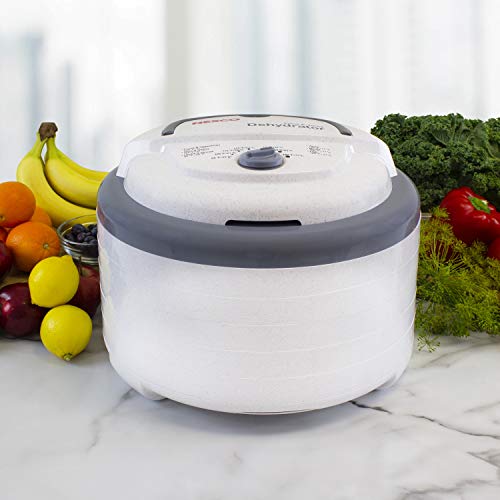
Nesco Snackmaster Pro, available on Amazon
The updated (and more expensive) model, the FD-77DT, has digital controls and a 24-hour timer. It also includes a few less accessories – four trays (it’s also expandable to 12), two tray screens, two fruit roll sheets, and a sample seasoning packet.
The 75A measures 13.75 by 22.13 by 13.87 inches, weighs 7.75 pounds, and offers 600 watts of power, while the 77DT measures 13.5 by 10.94 by 13.62 inches, weighs 7.25 pounds, and operates with 500 watts of power.
Otherwise, they operate identically, with a top-mounted fan and heater. This is a nice touch because it keeps liquid from dripping onto the heating element, which makes it easier to clean than those with bottom-mounted fans.
The thermostat is adjustable from 95 to 160°F.
Nesco has developed a patented drying system called Converga-Flow which, according to the manufacturer, creates vertical and horizontal airflow for fast, even, and nutritious drying.
In testing, however, while it performed well overall, items on the bottom trays dried more slowly than those on the top trays, so they had to be rotated for even drying.
Still, the 75A is one of the most popular models. We saw a few complaints about uneven drying, but very, very few considering the thousands of positive reviews this dehydrator gets.
Perfect for the beginner, the Snackmaster offers easy, reliable results, and the option to expand for larger quantities once you get your technique down pat.
It’s made in the USA with components made in China, and comes with a limited one-year warranty.
You can read more about this appliance in our review, or check current prices and read customer reviews now on Amazon.
5. L’EQUIP FilterPro 6-Tray Dehydrator
If you need a well-built unit that will dry foods effectively, and in large enough quantities to accommodate a gardener, hunter, or prepper, L’EQUIP FilterPro is both a solid performer and a good value.
This 530-watt dehydrator comes with six trays, and is expandable up to 20 trays. Two are extra deep for holding larger items. Each tray provides 1.2 square feet of drying surface.
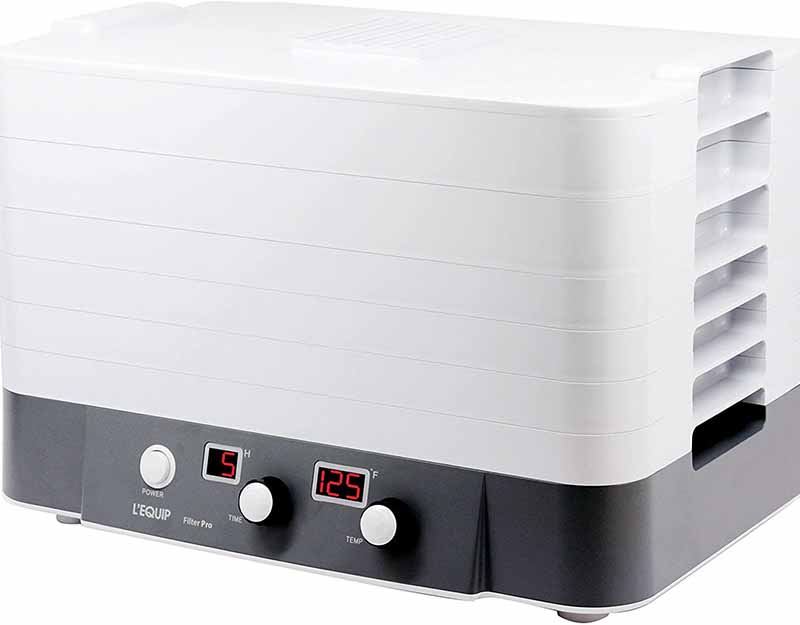
L’EQUIP FilterPro 6-Tray Dehydrator, available on Amazon
It also includes six mesh screens to keep smaller items from falling through, two fruit leather trays, and four yogurt cups.
The thermostat is adjustable from 98 to 158°F, and there is a 24-hour timer. This model measures 18 by 13 by 15 inches, and it weighs just shy of 13 pounds.
A proprietary technology referenced by the “FilterPro” in its name, the manufacturer claims this product uses a special air filtration system to keep impurities out of the food, but we found no specific testing to verify that.
It includes a replacement filter, and extras are available for purchase from the manufacturer.
L’EQUIP is definitely an attractive unit, rectangular with a vertical drying system, and the trays are stackable, which offers a very expansive capacity.
The motor and fan are located on the bottom of the unit, but are well-sealed enough that we saw no issues regarding cleaning or lingering odors.
The company offers a 10-year warranty on the motor, electronics, and base; and one year on parts, accessories, and plastics.
Find it now on Amazon or read our full review.
6. Aroma Professional 6-Tray Dehydrator
Are you looking to advance from stackable tray food dehydrators to the more advanced shelf tray models? If so, you may want to consider the Aroma Professional 6-Tray Dehydrator.
With a mid-size capacity of about 5.5 square feet, and the reliability of shelf tray performance, the Aroma Professional offers all the features you’re looking for in an attractive package.
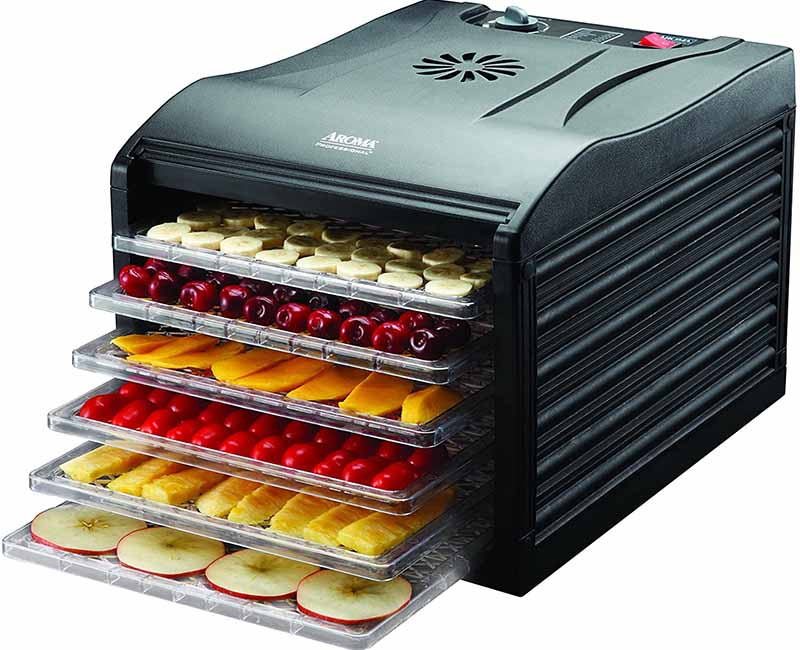
Aroma Professional 6-Tray Dehydrator, available on Amazon
It’s a horizontal shelf-type unit with the heating element and fan located on the back. A drip tray at the bottom helps to keep things clean.
It includes six trays, and is not expandable. A transparent door makes it easy to check on the drying progress.
This model measures 17.72 by 13.58 by 12.4 inches, and it weighs 11.68 pounds.
Rather than a sliding temperature scale, the Aroma has seven specific settings for jerky, fruits, vegetables, granola, yogurt, herbs, and potpourri.
It’s made in China and comes with a five-year warranty.
Read more about the Aroma Professional in our full review or check current prices on Amazon.
7. STX Dehydra 1200w 10-Rack Stainless Steel Dehydrator
For the serious food dehydrating enthusiast, the STX Dehydra offers a powerful 1200-watt drying system with a 16 square feet of capacity.
The variable thermostat is adjustable from 95 to 165°F. The rear-mounted heater and fan provide ample airflow to ensure proper dehydration.
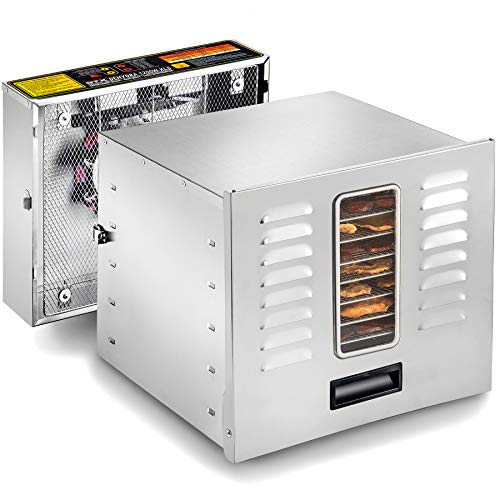
STX Dehydra 1200w, available on Amazon
This model measures 20 by 17.5 by 15 inches, and it weighs 38.5 pounds.
Both the generously sized trays and housing unit are constructed of durable 304-grade stainless steel. And this large commercial-grade unit boasts a fully digital control panel for added convenience, with a 12-hour shut-off timer.
Located at the higher end of the price scale, it’s for the purist who appreciates quality stainless materials, an extra-large capacity, and the power and durability to run almost continuously.
It also includes a one-year, 100-percent repair or replacement guarantee.
Read our complete review of the STX International here. Or you can find it now on Amazon.
Who Needs a Food Dehydrator?
A food dehydrator isn’t for everyone, but there are certain people and lifestyles that can definitely benefit from an investment in a good one.
Gardeners
If you grow your own fruits and vegetables, you know how quickly you can become overwhelmed when everything starts to ripen and mature at the same time.
Freezing, canning, and preserving are good options, of course, but dehydrating takes up much less storage space. Essentially, you are creating a shelf-stable product that doesn’t need to be placed in the freezer, or take up a lot of room in the cupboards.
Hikers, Campers, and Backpackers
When you’re hiking or backpacking, especially over long distances, you have to save weight and space, but you also must eat – and pre-packaged foods designed for hikers can be expensive.
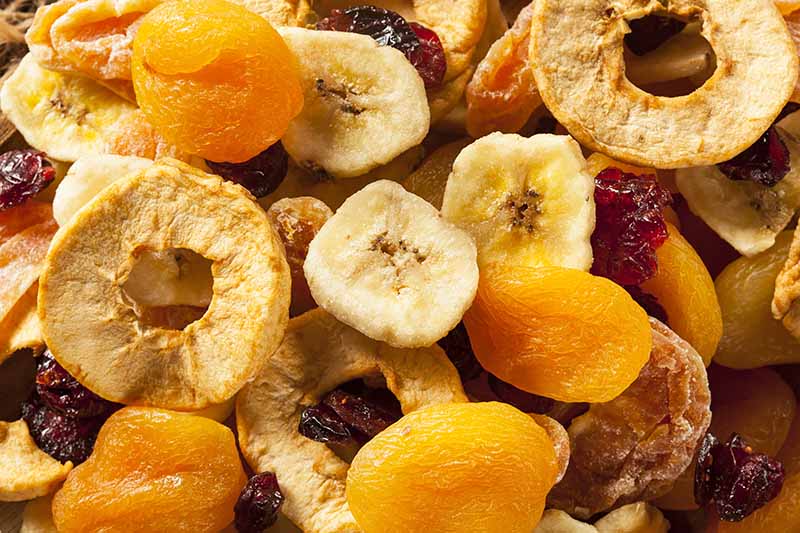
You can save money and customize your snacks and meals by making your own. Complete meals, like soups and stews, can also be packaged and quickly rehydrated for dinner.
Hunters
Bagging a big buck can quickly fill even the largest freezer.
Turning at least some of it into jerky not only helps to save storage space, it also means you can always have a delicious snack on hand.
And making your own means you know exactly what’s in it – commercial jerky often has added sugars, and other ingredients that you may prefer to leave out.
Raw Food Enthusiasts
Again, you can save money – and know what’s in your snacks! – if you prepare them yourself.
Although dehydrators are most often associated with fruit and jerky, you can dehydrate a wide variety of foods in them. Drying at a lower temperature, but for a longer time, will preserve those nutrients while fulfilling the requirements of a raw foods diet.
Preppers
For those of you who don’t know already, a prepper is someone who is preparing for a long-term disruption in society’s food sources, from a natural or manmade disaster. And dehydrating food has a long tradition in prepping culture.
Preserving food when it’s abundant means you’ll have some on hand in the event that it isn’t. And, of course, saving storage space is a serious concern when you’re trying to stockpile a large quantity of supplies.
Types of Food Dehydrators
All dehydrators work in the same way, as we’ve already noted, using air to circulate heat to gradually remove the moisture from food.
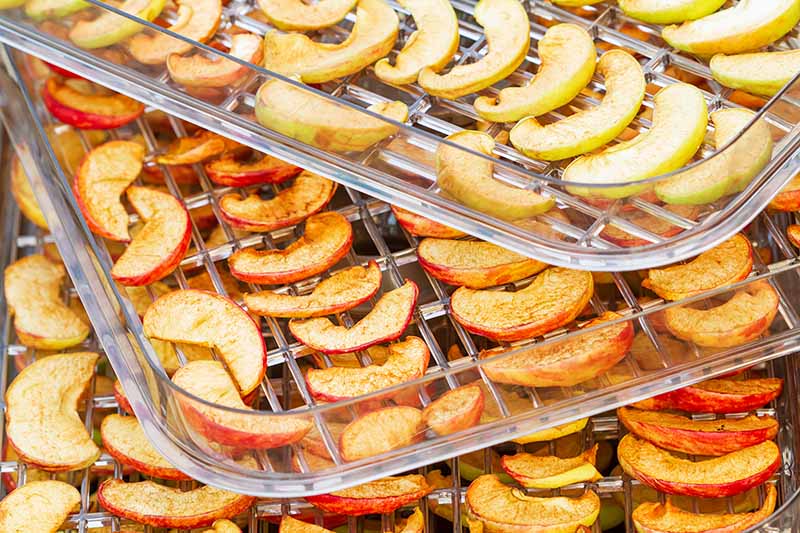
However, there are two different designs for doing so: horizontal and vertical. Here’s a quick look at each type.
Horizontal
Also called shelf tray dehydrators, these tend to be larger units, both in capacity and with a larger footprint as well.
Food is placed on trays that slide in and out of the unit, and the heat is distributed over the trays by a fan in the back.
These are more flexible to use, because you can remove or add trays for processing items of various sizes.
Vertical
These have a smaller footprint, and are often round in shape. The trays stack on top of each other, which is why they’re also often called stackable dehydrators.
The heat is distributed from either the bottom or the top of the unit, depending upon the model.
They also have a hole in the middle of each tray, so you can’t make true “sheets” of food (think fruit leather). Anything that would usually be made in an unbroken sheet will have a hole in the middle instead.
What to Look For
Various features come into play, depending on what types and quantities of food and other items you intend to process. Consider your needs before making your purchase.
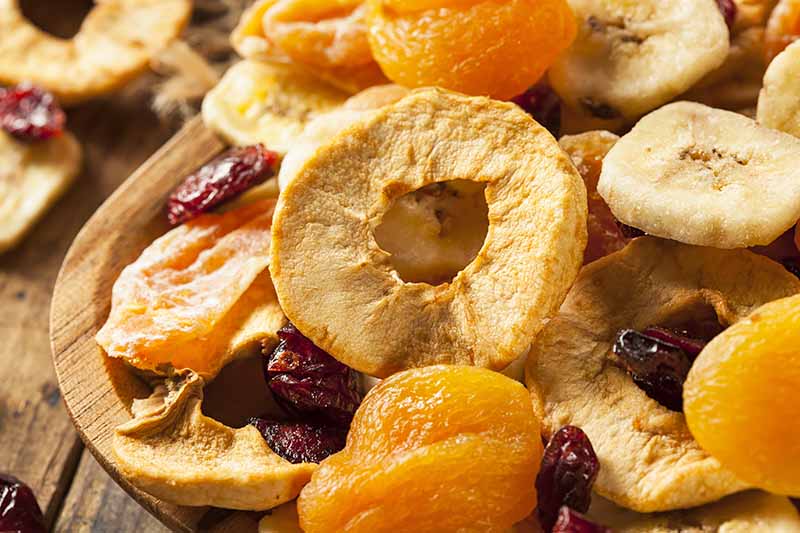
Below is a list of the top factors to review before you buy your appliance.
Capacity
This is the most important factor in choosing the right dehydrator. Drying food is time-consuming, so if you want to dry and store a lot, choose the largest dehydrator that will fit on your kitchen counter.
Horizontal machines are generally the best choice for processing larger quantities of food.
Features
Different types of foods dry at different temperatures, so most dehydrators have several settings available.
If you think you’ll only be drying a limited number of items – just fruit chips and leather, for example – you won’t need as many temperature settings, and can probably save some money by selecting an appliance that’s more restrictive in terms of power or the range of temperatures on offer.
Whether or not you need a timer is a matter of debate among experts; most seem to agree that they’re nice to have, but not essential.
They’re less helpful for the beginner, because there is a learning curve to drying food. If you’re just starting out, you’re going to want to check and be sure that whatever you’re processing is done before you take it out of the machine.
Once you get more familiar with the process, having a built-in timer is nice, so you can set the machine and leave it to shut off on its own without worrying about it.
Fans
In general, you’ll want your fan and heating element to be mounted on the top or side of your unit. This keeps juices from dripping on the element, potentially allowing it to retain strong odors. And this also makes it easier to clean.
However, some units with bottom-mounted fans do such a good job of sealing them, or include such an effective drip tray design, that they’re just as good as any other type.
Noise
As a long-time product reviewer, one of my favorite expressions is that “noise is in the ear of the beholder.” That means a product most people don’t even realize is running can be torture to those with ultra-sensitive hearing.
As a result, unless I see a lot of comments about the noise level of a particular unit or note our own complaints, I don’t really consider that as a crucial factor.
However, if noise is a big issue for you, be sure to read the full review of each of these products – we cover noise in detail there.
Food Safety
In the process of dehydration, approximately 90 to 95 percent of the moisture content is removed. It’s that moisture that causes food to “go bad,” so removing the majority of the moisture will increase its shelf life.
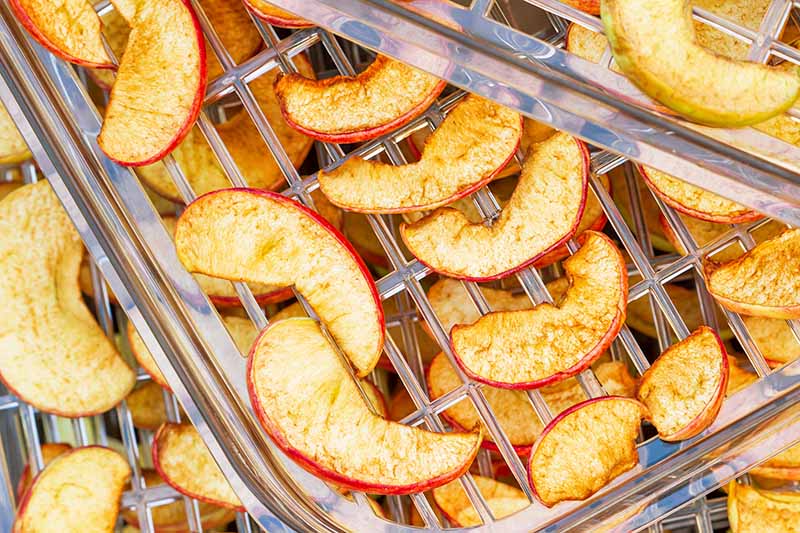
In general, experts say, dehydrated food will last about a year before it begins to spoil or lose nutrient value, as long as it is stored properly.
However, many enthusiasts say these items will often last much longer.
It’s also important to understand the difference between dehydrating and freeze-drying. Most pre-packaged food aimed at hikers and preppers is freeze-dried, not dehydrated.
Freeze-drying removes up to 99 percent of the moisture content, and these items have a longer shelf life as a result.
It’s important to label your dried goods so you know when they were prepared – all you really need for that is a permanent marker, maybe some stick-on labels, and some zip-top bags or tightly sealed jars. Oxygen absorbers or a vacuum sealer can also help.
And pay attention to what your senses tell you. Does something look or smell a little off? Then toss it. Period.
In my house, we have a hard and fast rule that I want to recommend to you as well: When in doubt, throw it out.
Getting Started
It’s important to understand what dehydrating food entails before you commit yourself to the process.
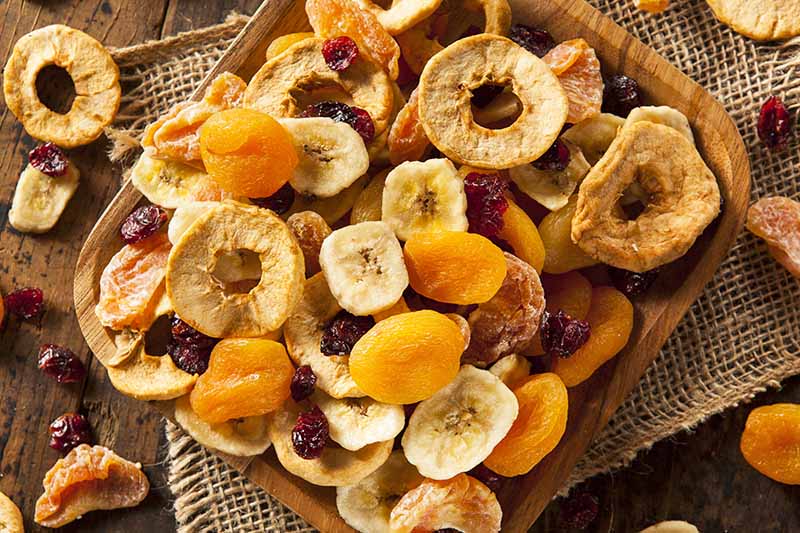
First of all, it’s time-consuming – up to 36 hours may be required for drying some items.
There is also a lot of prep involved. If you want to dry a bushel of apples or a side of beef, you have to slice them up first. You need to have, or be willing to learn, some halfway decent knife skills.
Having the right equipment can help you there, and we recommend the best kitchen knives and food processors to get the job done.
Additional Resources
Ready to get started? Read more about preserving your produce in Foodal’s Ultimate Guide to Dehydrating Your Garden’s Bounty.
We also invite you to head over to our sister site, Gardener’s Path, where we offer growing guides, product reviews, and more.
And don’t forget the old-fashioned way of learning: A good cookbook dedicated to dehydrating will be a big help in all aspects of learning, food safety, and more.
Last, but not least, the website of the National Center for Home Food Preservation offers a lot of valuable information to learn how to use your new appliance.
Dried Food Lovers, Unite!
It may seem like a diverse group, but anyone from gardeners to hunters and preppers, or just avid cooks and sale-seekers who like to shop in bulk, can find benefits in dehydrating their own food.
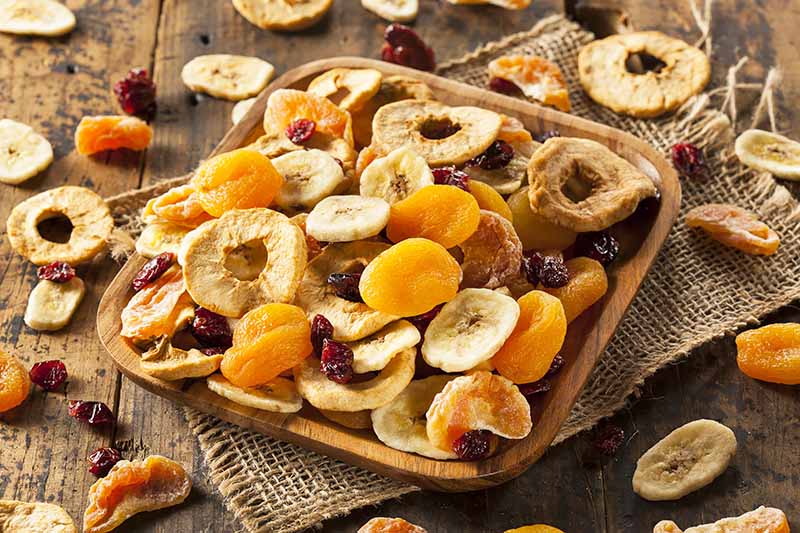
Just as there are many people who might want a dehydrator, there are as many uses for dried food as there are berries on a vine. Jerky, dried fruits, homemade roll-ups, kale and other types of veggie chips… You can even use your appliance for making potpourri, yogurt, and more!
Drying foods yourself saves money, and you’ll know exactly what’s in your snack or meal. With great dehydrators on the market at every price point, there’s no reason not to give it a try.
Have you ever used a food dehydrator? We’d love to know what you use yours for and what model you own or plan to buy. Tell us in the comment section below!
And for even more information on the best appliances and other kitchen gadgets and gear for home use, read these reviews next:
- Cover the Basics with Made In’s Plateware: All the Plates, Bowls, and Platters You’ll Need
- Power Up Your Baking with the Ankarsrum Assistent Original
- The Best Potato Ricers for the Best Mashed Spuds
© Ask the Experts, LLC. ALL RIGHTS RESERVED. See our TOS for more details. Product photos via Amazon. Uncredited photos via Shutterstock. Originally published on February 9, 2020. Last updated December 1, 2021. With additional writing and editing by Allison Sidhu.
About Kelly Burgess
Kelly Burgess is a product review specialist who loves food, kitchen gadgets, gardening, and writing. She was born and raised in Southern California, raised her kids in Pittsburgh, Pennsylvania, and now lives in Spokane, Washington with her husband and three cats. When she’s not cooking, eating or writing, Kelly likes to read, hang out with friends, hike, and explore the great Northwest.


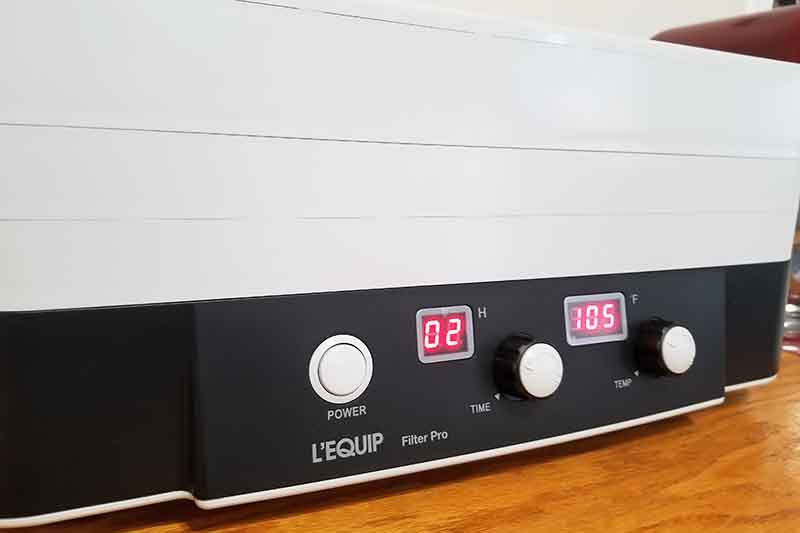

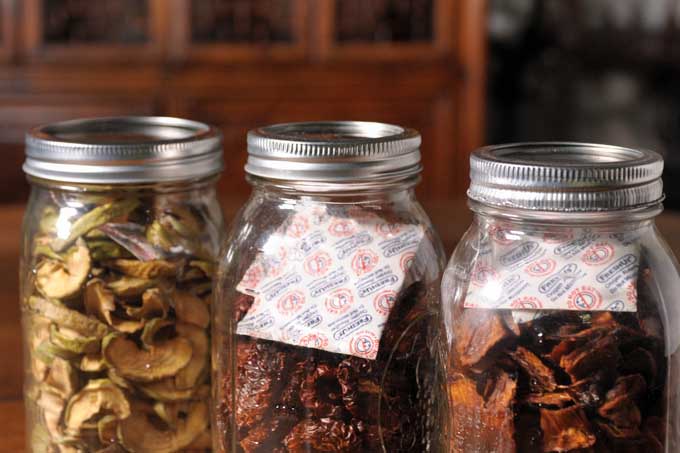
I love my dehydrator too! Even though I don’t have an Excalibur, I’m quite happy with my little round dehydrator as a starter model. So far I’ve dried apples, bananas, onions, and some herbs from my garden, and it’s fast becoming one of my favorite kitchen gadgets.
The only drawback is that it’s only 250W and does take longer to dry things. There’s no timer switch either – just on or off – but as it’s my first model, I am happy to keep practicing with drying other foods until I get a more grown up model.
Thanks for sharing your insight.
My mom had a dehydrator when I was little but I don’t remember us using it very often. I barely acquired one a couple of months ago and I’ve enjoyed having it. I really like making dried fruit and it’s much cheaper than buying them premade in stores. I have dried fruit and meat…I’d like to try dehydrating some new foods, if you have any suggestions.
I wouldn’t mind getting a dehydrator when I can afford one so that I can dry my own fruits and vegetables because I live really close to a store that sells lots of organic fare. Although I love the idea of canning, I like the idea of dehydrating certain foods as opposed to canning; there are some foods that I like much better dried, like apricots.
How to hydrate again dehydrated fruits ?
You can steep them for 15-20 minutes in hot water, or your choice of liquid.
This is one item I wish we owned again. I had one years ago and made jerky in it all of the time. It died and I’ve never replaced it. It was great for dried meats but that deep flavor tainted it somewhat and sometimes the Tex-Mex Fir Hot Beef Jerky flavor would linger no matter how much I cleaned it. Those flavors didn’t mix well with fruit. So, I guess if I do get another one I’ll have to get two. One for jerky and one for everything else.
Was it a vertical model where flavors or liquid dripped onto the fan at the bottom of the unit and were hard to clean off? I wonder if you would have the same problem with a horizontal unit or if horizontal might be better.
I love dry fruits and fruit and nuts mix! They can be quite pricy for a small amount though. I know a guy who only eats raw food; his dehydrator is his best friend, he makes many things with it, pizza for example. That’s a bit audacious for me!
I have to admit, we have a dehydrator but I’ve never actually used it, shame on me. I’m a bit more intrigued now though and will have to check out some recipes and get inspired. Homemade beef jerky sounds particularly good.
I would LOVE to own a food dehydrator! I am waiting for a sale that is impossible to pass up, I guess. I agree that it is important to buy one that is good quality, I’m sure it’s possible to waste a lot of money on dehydrators that break quickly or don’t work efficiently.
When I finally bite the bullet and get one, I will make my own fruit leather and sun dried tomatoes. I also saw a recipe for ‘raw’ crackers made from seeds, I might have to try to dig up that recipe at some point.
I’ve been considering getting a dehydrator for quite a while now. I’m glad I read this before I looked, because you brought up some good points. I definitely want something with enough power, and don’t want spills affecting the next batch I make. I will probably look at mid-market and mid-size/price for now. If I need more in the future, I will consider this Excalibur, it looks pretty impressive.
For a real treat you can always experiment with any kind of jerky you can think of. I like to go to this small grocery store that has a smaller deli in the back, and they’ll cut your meat right in front of you, through a glass window.
Just about any cut of meat can be used for jerky, so I’d get briskets, tenderloins, roasts, anything, and have them slice it 1/10″ thick. Bring it home and bathe it in my seasonings or marinades, and have jerky for weeks. One of the greatest things you’ll ever figure out is that you can make better tasting teriyaki jerky than you could ever buy. Some of the other flavors are hard to imitate, but teriyaki is the easiest and best, and it even tastes good on non-beef jerky.
Turkey, pork, deer, elk, rabbit, it’s all good. Just don’t try bacon. I tried that because it seemed like a good idea, but it really isn’t. All the fatty oils stay in the meat, so you end up with what is best described as magically half-cooked bacon.
Just in time for beef jerky and dehydrated apple slices!
I’ve been thinking about getting a dehydrator for some time. Excalibur crops up time and time again as one of the best buys on the market. I am in the UK, and the price for the Excalibur is around £400, which is ridiculous, but I’d sooner buy quality and buy once.
These look like some great options for any price point. I’m still considering buying one, particularly for dehydrating fruit and occasionally, for making jerky. I hadn’t considered drying nuts and seeds until re-reading this article. I love the idea of keeping ingredients on hand for when fresh aren’t available, and I had no idea that a stew could be make completely with dehydrated ingredients. That is a very attractive option for me, since I don’t live close to stores, and it’s sometimes a while in between shopping trips. I’m still not sure which model would be best for me, but I think any of the ones mentioned would suffice for my needs.
Thanks for this article. I put a food dehydrator on my wedding registry but I wasn’t sure which to buy. A lot of them feel like they are poor quality but are still pretty w expensive. I will definitely look into a bunch of these top rated ones.
I recently bought one from Weschenfelder. The cube dryer has 6 racks and you can set the temperature on it. It comes with a recipe guide so you know exactly how long to set the temperature at for whatever you’re cooking. It seems pretty good quality to me and all made in Italy which is reassuring.
I dry alot of elderberries and am having a hard time finding trays with fronts and sides that will keep the elderberries from falling all over the place. There are only a few on the market that have sides on their trays. I was really leaning toward the Excalibur, but their trays seem flimsy to me, especially if loaded with a slew of elderberries. What units would you suggest with the kind of trays I need? Last year I had 3 round dehydrators going at once but found trays did not dry uniformly and I had to keep switching them around (a real pain). I also read where you can use parchment paper on the trays which have larger openings. Does this interfere with the drying process? Is mesh the way to go?
Mesh definitely helps to promote airflow, and unfortunately it may be necessary to dry berries in smaller batches due to their size and tendency to roll around. Some dehydrators have customer liners available, which can make keeping everything where you put it without falling through the slats a bit easier.